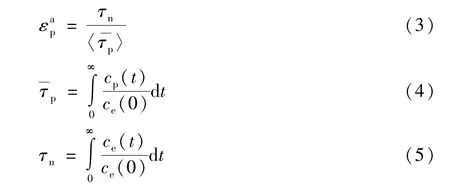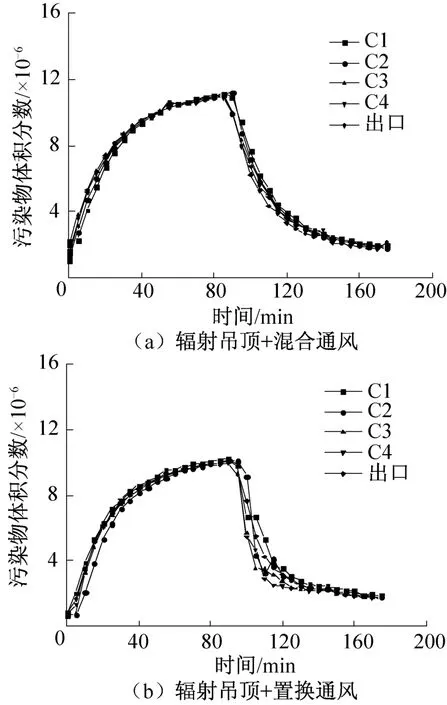辐射空调房间供暖期室内热环境及通风效率实验研究
吴小舟孙雪丰王沣浩
(1西安交通大学人居环境与建筑工程学院 西安 710049;2上海原构设计咨询有限公司辽宁分公司 沈阳 110000)
辐射空调房间供暖期室内热环境及通风效率实验研究
吴小舟1孙雪丰2王沣浩1
(1西安交通大学人居环境与建筑工程学院 西安 710049;2上海原构设计咨询有限公司辽宁分公司 沈阳 110000)
本文通过实验研究了供暖工况下辐射吊顶系统分别与混合通风系统和置换通风系统复合时办公房间室内热环境参数分布及新风系统的通风效率。结果表明:当辐射吊顶表面温度变化范围为25~29℃、送风温度变化范围为15~19℃及以换气次数表达的新风量等于4.2 h-1时,辐射吊顶供暖与混合通风房间室内垂直温差较小(不超过1℃)、空气紊流强度较大及新风系统的通风效率大约为1.0,而辐射吊顶供暖与置换通风房间室内垂直温差较大(最大能达到4℃),空气紊流强度较小及新风系统的通风效率为1.1左右。
辐射吊顶;混合通风;置换通风;室内热环境;通风效率
随着国民经济及中国城市化的不断发展,能源的需求量不断增加,相应的环境问题也日趋严重,节能减排已成为保证我国经济与社会健康、平稳发展的重大问题。当前我国建筑能耗占社会总能耗四分之一以上,其中建筑能耗50% ~60%为暖通空调能耗[1]。因此,面对节能减排的重大挑战,高效节能的空调新技术已成为暖通空调行业发展的主要方向之一。
近年来,清华大学的江亿院士等[2]基于热湿解耦处理方法提出了温湿度独立控制空调新技术。有别于常规对流空调系统的热湿耦合处理方法,温湿度独立控制空调系统采用温度控制系统及湿度控制系统分别调节控制室内温度及湿度。由于除湿的任务由独立的湿度控制系统承担,因而温度控制系统的冷水供水温度可以提高到16~18℃,可以显著提高能源利用效率,降低空调系统能耗[2]。为了满足现代绿色建筑的要求,目前常见的温湿度独立控制空调系统由适合大流量小温差的辐射吊顶供冷系统及独立新风系统构成,国内称为辐射空调系统[3-6]。
D.L.Loveday等[7]和S.G.Hodder等[8]的研究表明,当送风温度为19℃,送风量变化范围为3.0 ~3.9 h-1及吊顶表面温度变化范围为12~22℃时,PMV(predicted mean vote)指标[9]仍然适用于评价辐射吊顶供冷与置换通风房间室内热环境。S.Schia⁃von等[10]对辐射吊顶供冷与置换通风房间室内温度分布进行了实验研究,发现房间下层空气垂直温度呈线性分布,而房间上层空气受到冷却顶板产生的下降冷气流作用温度梯度较小。路诗奎等[11]利用CFD软件对辐射吊顶供冷与置换通风室内温度分布进行了数值模拟,并与实验结果进行了对比,结果表明在夏季运行工况下,辐射空调系统可以提供优于常规对流空调系统的热环境。
虽然国内外许多学者对辐射空调房间供冷期室内热环境及通风效率进行大量的研究,但对辐射空调在供暖期相关性能研究较少。本文的研究对象为供暖工况下,辐射吊顶系统分别与混合通风系统和置换通风系统复合时的办公房间,研究了辐射吊顶供暖与供新风房间室内热环境参数分布及新风系统的通风效率,为辐射空调技术的应用提供理论支撑。
1 室内热环境与通风效率的实验方法
1.1 测试房间及测试系统
测试房间长×宽×高为12 m×6 m×2.7 m,如图1所示[12]。测试系统包括辐射吊顶供暖与混合通风复合系统,辐射吊顶供暖与置换通风复合系统,如图2所示。

图1测试房间及测点布置图Fig.1 Diagram of test room and measurement point

图2测试系统原理图Fig.2 Diagram of test systems
通风系统送风温度和流量设为常数,调节吊顶表面温度,控制室内空气温度保持为22℃(具体为房间中心离地1.1 m处的空气温度),如表1所示。

表1测试工况及边界条件Tab.1 Test cases and boundary conditions
实验中通过调节通风系统冷热盘管可以精确控制送风温度,根据实验要求,相同工况下混合通风和置换通风的送风温度相同。同样,通过调节风机频率可以精确控制通风系统送风量,根据实验要求,相同工况下混合通风和置换通风的送风量相同。但由于混合通风与置换通风的风口有效面积不同,分别为0.046 m2和 0.14 m2,因此对应的风速分别为4.8 m/s和1.6 m/s。
为了节能,新风系统一般带有热回收。为了避免结霜,新风系统的进风温度不能低于-10℃,否则需要对新风进行预热,而预热后的空气温度不应高于5℃。目前显热回收装置的能效可达80%,因此新风系统的送风温度变化为15~19℃。吊顶表面温度按照标准ISO 7730[13]不能高于29℃,因此吊顶表面温度变化范围为25~29℃。
1.2 测试参数及计算公式
1)室内热环境
采用球形探头测试室内空气温度及室内空气速度,标定后测量误差分别为±0.1℃和 ±(0.02+0.02v)m/s,其中v为空气速度读值。室内空气温度及室内空气速度垂直测点布置是依据室内热环境测试标准ISO 7726[14],主要位于人员的活动区域:0.1 m、0.6 m、1.1 m及1.7 m。由于测试房间是对称的,室内热环境参数水平测点布置主要集中在房间的半边(测点P1~P4),如图1所示。
室内垂直空气温差及距离地面1.1 m处空气紊流强度计算公式如式(1)及式(2)所示[13]。

式中:ta1.1为距离地面1.1 m处的空气温度,℃;ta0.1是距离地面0.1 m处的空气温度,℃。

式中:Tu为空气紊流强度;SDv为距离地面1.1 m处空气速度标准偏差,m/s;为距离地面1.1 m处平均空气速度,m/s。
2)通风效率
在室内热环境参数记录完毕后,系统运行参数不变,利用Innova系统释放和采集示踪气体,进行新风系统的通风效率测试。采用R134a作为污染物,测点C1~C4位于办公人员头部附近并距离地面1.1 m,如图1所示。
依据标准 ASHRAE 129[15]采用衰变法(decay method)进行通风效率测试,包括室内人员活动区内污染物瞬时体积分数和回风口处污染物瞬时体积分数测试,计算如式(3)~式(5)所示[15]。

式中:τn为时间常数,s;p为局部平均空气年龄,s;cp(t)为室内活动区内污染物瞬时体积分数(10-6);ce(t)为回风口处污染物瞬时体积分数(10-6)。
2 室内热环境及通风效率测试结果与分析
2.1 室内热环境测试结果与分析
1)室内空气温度分布的测试结果与分析
辐射吊顶系统分别与混合通风系统及置换通风系统复合时,房间室内空气温度如图3~图5所示。

图3 工况Ⅰ时房间室内空气温度分布Fig.3 Vertical distribution of air temperature for caseⅠ

图4 工况Ⅱ时房间室内空气温度分布Fig.4 Vertical distribution of air temperature for caseⅡ
由图3~图5可知,送风温度和辐射吊顶表面温度在相应的温度范围变化时,辐射吊顶供暖与混合通风房间活动区内室内空气温度分布较均匀,辐射吊顶供暖与置换通风房间活动区内室内空气温度分布较不均匀,如表2所示。
辐射吊顶系统分别与混合通风系统及置换通风系统复合时,房间室内垂直温差计算结果如表2所示。
由表2可知,送风温度和辐射吊顶表面温度在相应的温度范围变化时,辐射吊顶供暖与混合通风房间的室内垂直温差较小,不超过1℃;而辐射吊顶供暖与置换通风房间的室内垂直温差较大,最大可达4℃,大于热舒适标准ISO 7730的限定范围。这主要是由于混合通风房间室内空气混合比较充分,而置换通风房间室内空气混合较少,室内有明显的垂直热分层现象。此外,外围护结构冷壁面产生的下沉冷气流对室内空气流动也有一定影响。

图5 工况Ⅲ时房间室内空气温度分布Fig.5 Vertical distribution of air temperature for caseⅢ

表2 室内垂直温差计算结果(单位:℃)Tab.2 Calculation result of vertical air temperature difference
2)室内空气速度分布的测试结果与分析
辐射吊顶系统分别与混合通风系统及置换通风系统复合时,房间室内空气速度分布如图6~图8所示。
由图6~图8可知,送风温度和辐射吊顶表面温度在相应的温度范围变化时,辐射吊顶供暖与混合通风房间活动区内室内空气速度分布较均匀,辐射吊顶供暖与置换通风房间活动区内室内空气速度分布较不均匀。
辐射吊顶系统分别与混合通风系统及置换通风系统复合时,房间室内空气紊流强度计算结果如表3所示。

图6 工况Ⅰ时房间室内空气速度分布Fig.6 Vertical distribution of air velocity for caseⅠ
由表3可知,送风温度和辐射吊顶表面温度在相应的温度范围变化时,辐射吊顶供暖与混合通风房间的室内空气紊流强度较大,而辐射吊顶供暖与置换通风房间的室内空气紊流强度较小,与H.Hanzawa等[16]的研究结果一致。这主要是因为混合通风系统直接向工作区输送冷空气,射流作用导致人体坐着脖子附近的空气速度波动较大。而对于置换通风系统,空气流动主要由热浮力控制,导致人体坐着脖子附近的空气速度波动较小。
2.2 通风效率测试结果与分析
辐射吊顶系统分别与混合通风系统及置换通风系统复合时房间室内污染物浓度变化如图9~图11所示。

图7 工况Ⅱ时房间室内空气速度分布Fig.7 Vertical distribution of air velocity for caseⅡ

图8 工况Ⅲ时房间室内空气速度分布Fig.8 Vertical distribution of air velocity for caseⅢ

表3 室内空气紊流强度Tu计算结果(单位:%)Tab.3 Calculation result of turbulence intensity
由图9~图11可知,送风温度和辐射吊顶表面温度在相应的温度范围变化时,辐射吊顶供暖与混合通风房间和辐射吊顶供暖与置换通风房间活动区内室内污染物浓度变化基本一致。将室内活动区内污染物瞬时浓度和回风口污染物瞬时浓度代入式(4)~式(6)中,计算可得辐射吊顶系统分别与混合通风系统和置换通风系统复合的通风效率,如表4所示。

表4 室内新风系统通风效率计算结果Tab.4 Calculation result of ventilation effectiveness

图9 工况Ⅰ时房间室内污染物体积分数变化Fig.9 Indoor contaminant distribution for caseⅠ

图10 工况Ⅱ时房间室内污染物体积分数变化Fig.10 Indoor contaminant distribution for caseⅡ

图11 工况Ⅲ时房间室内污染物体积分数变化Fig.11 Indoor contaminant distribution for caseⅢ
由表4可知,送风温度和辐射吊顶表面温度在相应的温度范围变化时,辐射吊顶供暖与混合通风房间的通风效率约为1.0,与ASHRAE 62.1标准[17]中规定的推荐值(1.0)相等;而辐射吊顶供暖与置换通风房间的通风效率为1.1左右,略低于ASHRAE标准中规定的推荐值(1.2),并当送风温度为19℃及辐射吊顶表面温度为27℃时通风效率达到最大。
3 结论
本文以供暖工况下辐射吊顶系统分别与混合通风系统和置换通风系统复合时办公房间为研究对象,通过测试研究辐射吊顶供暖与供新风房间室内热环境参数分布及新风系统的通风效率,当辐射吊顶表面温度变化范围为25~29℃、送风温度变化范围为15 ~19℃及以换气次数表达的新风量为4.2 h-1时,得到以下结论:
1)对于辐射吊顶供暖与混合通风房间,送风温度和吊顶表面温度的变化对室内热环境及新风系统的通风效率的影响较小。
2)对于辐射吊顶供暖与置换通风房间,送风温度和吊顶表面温度的变化对室内热环境及新风系统通风效率影响较大。当送风温度为19℃及辐射吊顶表面温度为27℃时,室内热环境可接受及新风系统通风效率达到最大。
本文受陕西省自然科学基础研究计划(2016JQ5081)和西安市科技计划项目(CXY1514(3))资助。(The project was supported by Natural Science Basic Research Plan in Shaanxi Province of China(No.2016JQ5081)and Xi′an Science and Technology Research Plan(No.CXY1514(3).)
[1] 江亿.中国的建筑节能-现状、问题和解决途径[R].北京:清华大学建筑节能研究中心,2009,13⁃15. (JIANG Yi.The status,problem and solution method of building energy conservation[R].Beijing:Builing Energy Conservation Research Center,Tsinghua University,2009,13⁃15.)
[2] Liu X H,Jiang Y,Zhang T.Temperature and humidity in⁃dependent control(THIC)of air-conditioning system [M].Berlin:Springer Press,2013,22⁃24.
[3] 金跃.清华大学环境能源楼设计[J].暖通空调,2007,37(6):73⁃75.(JIN Yue.Design for the Sino⁃Italian eco⁃logical and energy efficient building of Tsinghua University [J].Journal of HV&AC,2007,37(6):73⁃75.)
[4] Baldin F.An experimental study of comfort and air distri⁃bution in a room with radiant floor heating/codling and dis⁃placement ventilation[D].Copenhagen:Technical Univer⁃sity of Denmark,2008:21⁃23.
[5] Zhao K,Liu X H,Zhang T,et al.Performance of temper⁃ature and humidity independent control air⁃conditioning system in an office building[J].Energy and Buildings,2011,43(8):1895⁃1903.
[6] Zhang T,Liu X,Zhang L,et al.Performance analysis of the air⁃conditioning system in Xi′an Xianyang International Airport[J].Energy and Buildings,2013,59(7):11⁃20.
[7] Loveday D L,Parsons K C,Taki A H,et al.Displace⁃ment ventilation environments with chilled ceilings:thermal comfort design within the context of the BS EN ISO7730 versus adaptive debate[J].Energy and Buildings,2002,34(6):573⁃579.
[8] Hodder S G,Loveday D L,Parsons K C,et al.Thermal comfort in chilled ceiling and displacement ventilation envi⁃ronments:vertical radiant temperature asymmetry effects [J].Energy and Buildings,1998,27(2):167⁃173.
[9] Fanger P O.Thermal comfort:analysis and applications in environmental engineering[D].Copenhagen:Technical U⁃ niversity of Denmark,1970,44⁃48.
[10]Schiavon S,Bauman F,Tully B,et al.Room air stratifica⁃tion in combined chilled ceiling and displacement ventila⁃tion systems[J].HVAC&R Research,2012,18(1):147⁃159.
[11]路诗奎,吕艳,张小松,等.辐射供冷/置换通风空调系统的数值模拟与实验[J].建筑热能通风空调,2010,27(2):25⁃29.(LU Shikui,LYU Yan,ZHANG Xi⁃aosong,et al.Numerical simulation and experimental study of radiant cooling and displacement ventilation[J].Build⁃ing Energy and Ventilation,2010,27(2):25⁃29.)
[12]吴小舟,赵加宁,王沣浩.低温辐射地板供暖与供新风室内热环境及通风效率实验研究[J].暖通空调,2015,45 (9):64⁃69.(WU Xiaozhou,ZHAO Jianing,WANG Fenghao.Experimental study of indoor thermal environment and ventilation effectiveness in a room with low temperature radiant floor heating system and ventilation system[J]. Journal of HV&AC,2015,45(9):64⁃69.)
[13]ISO 7730,Ergonomics of the thermal environment—analyt⁃ical determination and interpretation of thermal comfort u⁃sing calculation of the PMV and PPD indices and local thermal comfort criteria[S].Geneva:International Stand⁃ard Organization For Standardization,2005.
[14]ISO 7726.Ergonomics of the thermal environment⁃instru⁃ments for measuring physical quantities[S].Geneva:Inter⁃national Standard Organization for Standardization,1998.
[15]ASHRAE 129.Measuring air change effectiveness[S].At⁃lanta:American Society of Heating.Atlanta:.Refrigeration and Air Conditioning Engineers,Inc.,1997.
[16]Hanzawa H,Melikov A K,Fanger P O.Airflow character⁃istics in the occupied zone of ventilated spaces[J]. ASHRAE Trans.,1987,93(2),524⁃531.
[17]ASHRAE 62.1,Ventilation for acceptable indoor air quali⁃ty[S].Atlanta:American Society of Heating,Refrigerating and Air⁃Conditioning Engineers,Inc.,2007.
Experimental Study of Indoor Thermal Environment and Ventilation Effectiveness in a Room with Ceiling Heating and Mechanical Ventilation
Wu Xiaozhou Sun Xuefeng2Wang Fenghao1
(1.School of Human Settlement and Civil Engineering,Xi′an Jiaotong University,Xi′an,710049,China;2.Shang⁃hai Yuangou Design Consulting Co.,Ltd.,Shenyang,110000,China)
Experimental studies of indoor thermal environment and ventilation effectiveness were performed in a room with low temperature radiant ceiling heating system combined with mixing ventilation system and displacement ventilation system.The results show that when ra⁃diant ceiling surface temperature ranges from 25 to 29℃,supply air temperature ranges from 15 to 19℃ and supply air flow rate equals 4.2 h-1,the distribution of indoor thermal environmental parameters are relatively uniform,the indoor vertical air temperature differences are less than 1℃ and ventilation effectiveness is approximately 1.0 when low temperature radiant ceiling heating system is integrated with mixing ventilation system.The distribution of indoor thermal environmental parameters are relatively non⁃uniform,and the indoor vertical air temperature differences are large and up to 4℃ and ventilation effectiveness is approximately 1.1 when low temperature radiant ceiling heating system is integrated with displacement ventilation system.
radiant ceiling;mixing ventilation;displacement ventilation;indoor thermal environment;ventilation effectiveness
TU832.1+6;TU834.3
A
0253-4339(2017)01-0040-07
10.3969/j.issn.0253-4339.2017.01.040
国家自然科学基金(51408482)资助项目。(The project was supported by the National Natural Science Foundation of China(No. 51408482).)
2016年4月14日
吴小舟,男,副教授,西安交通大学人居环境与建筑工程学院,18991848252,E⁃mail:fonen519@mail.xjtu.edu.cn。研究方向:辐射空调基础理论及应用。
About the corresponding author
Wu Xiaozhou,male,associate professor,School of Human Settle⁃ment and Civil Engineering,Xi′an Jiaotong Univeristy, +86 18991848252,E⁃mail:fonen519@mail.xjtu.edu.cn.Research fields:radiant heating and cooling technology.

